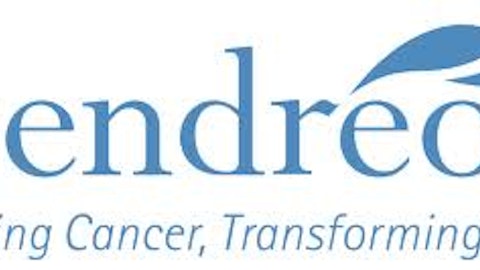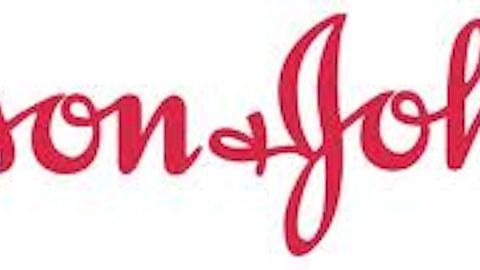Johnson & Johnson (NYSE:JNJ) reported its second quarter on Tuesday, and turned in some positive numbers. Revenue grew 8.5%, year-over-year, up to $17.9 billion. The EPS was higher than analyst estimates, and the company upped its full-year guidance.

But the details are where things get interesting. Here are three key takeaways from the earnings report — and what they mean for Johnson & Johnson (NYSE:JNJ)’s future.
1. Infectious disease and oncology drove pharma growth
Total worldwide pharmaceuticals had a reported sales growth of 11.7% to $7.025 billion. Most of that growth came from infectious disease and oncology. Reported sales for these segments grew 23.1% and 51%, respectively.
Prostate cancer drug Zytiga was the oncology champion, growing 70.3% worldwide to $395 million. According to Johnson & Johnson (NYSE:JNJ), Zytiga now holds over 30% of the global market for metastatic castrate-resistant prostate cancer.
Zytiga received Food and Drug Administration approval in early 2011 for usage after chemotherapy. But the drug received approval late last year to become a first-line treatment. Zytiga’s second quarter growth was due to that expanded indication and the rollout of the drug into additional international markets.
The highest growth in the infectious disease segment belonged to the hepatitis C protease inhibitor Incivek, which grew 68.6% worldwide mostly due to additional international rollouts. That growth only equaled sales of $172 million for Johnson & Johnson (NYSE:JNJ) because Incivek is a partnered drug with Vertex Pharmaceuticals Incorporated (NASDAQ:VRTX) and Johnson & Johnson (NYSE:JNJ) is on the smaller side of that deal. Vertex Pharmaceuticals Incorporated (NASDAQ:VRTX)’s first quarter report showed Incivek’s net product revenues at $206.5 million. But these protease inhibitors will likely lose substantial market share once the all-oral HCV drugs come to market.
The more interesting infectious disease story is HIV treatment Prezista, which had 16.6% worldwide growth to $435 million. Growth was fairly consistent between the U.S. and international, and this drug has been approved for over five years. So what we’re seeing here is organic growth caused by more patients adopting the drug.
2. Stagnant device growth will improve
Worldwide device growth was only 4% for the quarter, with most segments holding steady while diabetes device sales fell. But those figures aren’t including the recently finalized Syntes merger, which brings things up to a 48.9% worldwide growth.
Johnson & Johnson (NYSE:JNJ) shelled out $21.3 billion for Syntes back in 2011. Syntes is a market leader in trauma devices including bone grafts and plates. Johnson has now merged Syntes with its previously existing DePuy subsidiary.
3. The future looks brighter
Johnson & Johnson slightly increased its 2013 earnings guidance to the range of $5.40 to $5.47 – up from the $5.35 to $5.45 previously announced. And there’s reason for optimism.
The company’s new diabetes drug Invokana will hit the market as the first-in-class SGLT2 in the United States. Analysts have pegged Invokana’s potential earnings in the blockbuster territory.
Its closest competitor — Forxiga from Bristol Myers Squibb Co. (NYSE:BMY) — was delayed by FDA safety questions regarding potential cancer risks. Eli Lilly & Co. (NYSE:LLY) also has a pipeline SGLT2 drug that could make it to market, but Eli Lilly & Co. (NYSE:LLY)’s recent string of late-stage cancellations isn’t exactly encouraging.
Johnson & Johnson’s pipeline also includes promising candidates in HCV and rheumatoid arthritis. And unlike Eli Lilly & Co. (NYSE:LLY), most of Johnson & Johnson’s products make it through late-stage trials without major disappointments.
Foolish final thoughts
Johnson & Johnson’s looking stable where others are tripping over failed pipeline projects. There’s also the steadily growing 2.9% dividend to sweeten the pot. This company remains a good bet for investors who want to buy for the long term.
Brandy Betz has no position in any stocks mentioned. The Motley Fool recommends Johnson & Johnson and Vertex Pharmaceuticals (NASDAQ:VRTX). The Motley Fool owns shares of Johnson & Johnson. Brandy is a member of The Motley Fool Blog Network — entries represent the personal opinion of the blogger and are not formally edited.
The article 3 Key Takeaways From JNJ’s Q2 originally appeared on Fool.com is written by Brandy Betz.
Copyright © 1995 – 2013 The Motley Fool, LLC. All rights reserved. The Motley Fool has a disclosure policy.


